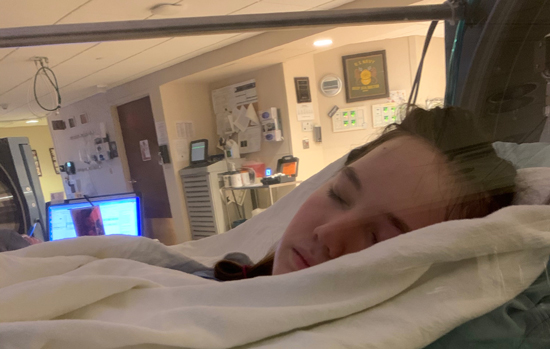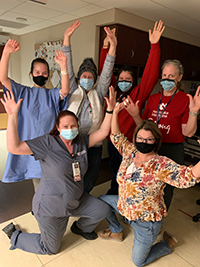
The family of Sayda Woodbury shares how the Hyperbaric Oxygen Unit helped their daughter recover from an infection in her brain.
It all started somewhat unremarkably. Sayda Woodbury, a 16-year-old sophomore at Sergeant Bluff-Luton High School in Iowa, told her mom, Janelle Woodbury, her fingers felt funny.
“Her grip wasn't right," Janelle says.
A week before, Sayda was ill with flu-like symptoms, and Janelle wondered if she simply pinched a nerve. But the next day, she couldn't move her wrist or her fingers.
“My husband sees a chiropractor, so we decided to see if this was a pinched nerve," she says. “The chiropractor said, ‘this is bigger than what I can do'."

Janelle was instructed to take Sayda to her primary care physician, who told Janelle to take Sayda to an emergency department. The family ended up at St. Luke's Regional Medical Center in Sioux City, Iowa, where an MRI revealed 38 lesions on Sayda's brain and one on her brain stem.
“They told me she needed to go to Omaha," Janelle recalls.
That was at 1 a.m. on Feb. 16. By 5 a.m., Sayda was in surgery at Nebraska Medical Center, where pediatric neurosurgeon Linden Fornoff, MD, took a biopsy from the largest lesion.
“I joke that I went to the chiropractor and ended up in brain surgery," Sayda says. She has no recollection of the early morning hours before her surgery.
Fortunately, it was determined the lesions were caused by an infection known as Streptococcus intermedius.
“The infectious disease doctors had so many questions for Sayda, like ‘where have you been?' ‘have you played with chickens?' ‘were you moving dirt?' We learned along about infections and the blood/brain barrier," Janelle says.
To this day, the family has no idea how Sayda acquired the infection.
Fortunately, along with antibiotics, Nebraska Medical Center offers another weapon in its arsenal – hyperbaric medicine.
“They told us the infection does not like oxygen," Sayda's father, Cliff Woodbury, says. “We knew the antibiotics would work. I said, let's do whatever it takes to help her. Let's throw everything at it."
At that point, the paralysis had spread to Sayda's right shoulder and the right side of her face.
“It was amazing how quickly she began to recover," Janelle says. “Her face came back very quickly. And then her mobility in her shoulder, elbow and wrist improved a little bit each day."
In all, Sayda underwent 20 treatments in the Hyperbaric Oxygen Unit, where patients lay in a chamber and receive 100% oxygen that is three times the normal atmospheric pressure. It increases the oxygen concentration in the blood and body tissues.

“When Sayda started HBO treatments, she was barely able to mover her right hand and arm due to the effects from the brain abscess," says Kari Fowler, staff nurse, HBO. “While Sayda received antibiotics, abscess drainage, physical and occupational therapy, the administration of 100% oxygen helped to increase the oxygenation of any hypoxic tissues. Sayda's outcome is the result of the successful collaboration of many disciplines, as well as the energy and determination of a 16-year-old and her family."
She was discharged home on March 2.
“All the nurses, everyone who cared for me, they were great," says Sayda. “I feel very lucky and thankful."
Sayda's illness meant she had to miss her show choir competition season. But she's looking forward to returning to school and has most of her mobility back.
“The whole thing was surreal," she says. “If you told me it never happened, I would believe you."
“I truly believe we were in the best hands possible," Janelle says. “Everything happens for a reason. We are so thankful to all the people who cared for her. They took away the fear, and they reassured us we were right where we needed to be."

